Bacteria

Bacteria are microscopic organisms, single-celled creatures which live mostly on the surfaces of objects where they grow as colonies. Bacteria are very important both to the world as a whole and to mankind in particular. Bacteria are important in making soil, feeding cows, controlling insects, making medicines, making bioplastics, making plants grow, degrading pollutants such as oil and plastics as well as in causing disease. Microbiology is a huge and growing industry and even if you never intend to study microbiology any further than these pages it will be good for you to have some appreciation of the roles bacteria play in all our lives. Studying something you cannot see, something which is not pretty, colourful or cute in any form is perhaps a more cerebral activity than many people would like. Bacteria are, however, amazing creatures and I have attempted to make the information here as much fun and as interesting as possible. I hope that this will allow you to experience a little of the amazement bacteria stimulate in the many people who study them. However by the very nature of their small size and the limitations this puts on us when we studying them much of the information is a bit dry and chemical. I apollogise for this.
Bacteria are one of the most ancient of living things and scientists believe they have been on this planet for nearly 4,000 million years. During this time they have acquired lots of fascinating and different ways of living. They also come in a variety of shapes. The simplest shape is a round sphere or ball. Bacteria formed like this are called cocci (singular coccus). The next simplest shape is cylindrical. Cylindrical bacteria are called rods (singular rod). Some bacteria are basically rods but instead of being straight they are twisted or bent or curved, sometimes in a spiral – these bacteria are called spirilla (singular spirillum). Spirochaetes are tightly coiled up bacteria.
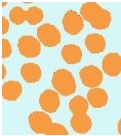 |
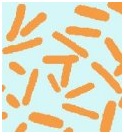 |
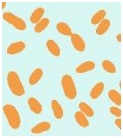 |
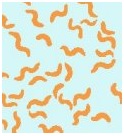 |
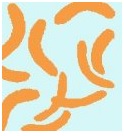 |
 |
 |
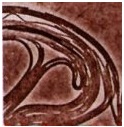 |
Bacteria are friendly creatures, you never find one bacteria on its own. They tend to live together in clumps, chains or planes. When they live in chains, one after the other, they are called filamentous bacteria – these often have long thin cells. When they tend to collect in a plane or a thin layer over the surface of an object they are called a biofilm. Many bacteria exist as a biofilm and the study of biofilms is very important. Biofilm bacteria secrete sticky substances that form a sort of gel in which they live. The plaque on your teeth that causes tooth decay is a biofilm.
Friends and Enemies
It is part of the human condition that we tend to be consciously aware of those few bacteria that are pathogens whilst ignoring all those useful species without which life would not be possible. It is important to realise that many, many more bacteria are involved in interactions that are beneficial to the other party than in interactions that are harmful. Some of these cause disease, but others help us digest our food. Many animals are completely dependent on bacteria to digest their food for them, particularly herbivores, large vertebrates like cows and sheep, to small invertebrates like termites and collembola all are dependant on there comensal bacteria to stay alive. Further to this bacteria are responsible for much good in medicine, they produce the best antibiotics and with the help of modern microbiological techniques they can now be used to produce many medically import products and even biodegradable planet friendly plastics
Most bacterial species are un-named and unidentified, tens of thousands of species have been isolated, though they may not yet be allocated to a family or genera etc. There are more than 15,000 known species of bacteria living in the sea. There are about 5000 named species of bacterium in 805 genera. The distribution is skewed with 397 genera being monotypic, meaning there is only one species in the genera. This leaves an average of 10 species per genus for the remaining 409 genera, however, only 89 genera have 10 or more species in them and nearly one third of all known bacteria (32.87%) are to be found confined to just 16 genera. The most populous genus is Streptomyces with 509 species.
Note that the above information, and other taxonomic information used on this site was synopsed from a pre 1998 1st edition of Bergey’s Manual of Systematic Bacteriology. Considerable forward strides have been made since then in bacterial taxonomy and the new 2001 2nd Edition of the above manual is available from Springer-Verlag New York.
However it is worth noting that there are many distinct varieties of some species and the concept of a species is sometimes a bit fuzzy. Also, and perhaps more importantly there remain thousands of species of bacteria undiscovered and or unnamed. At the beginning of this century Australian scientists looking at the bacteria in the stomachs of Kangaroos for species that could produce acetates rather than methane from hydrogen and found over forty species with this capability, half of which were completely new species as far as science was concerned. This is just one example of the huge reservoir of unknown bacteria waiting to be discovered. Some microbiologists claim there may even be more species of bacteria than there are of insects. Insects are currently the most speciose taxon known to man, at least in terms of named species with over a million known species.
| The top 10 genera which contain 27% of all species are: | |
| Genera | Species No. |
| Bacteroides | 65 |
| Corynebacterium | 67 |
| Streptococcus | 68 |
| Mycobacterium | 85 |
| Lactobacillus | 100 |
| Mycoplasma | 110 |
| Bacillus | 114 |
| Pseudomonas | 117 |
| Clostridium | 146 |
| Streptomyces | 509 |
It is a fact that bacteria live in a whole series of worlds which stretch our imagination, be it the clouds in the sky, an Antarctic ice flow, a 100 degree C hot sulphur spring, 10 km down at the bottom of the sea, 1500 m below the surface of the earth in solid rock, in a rotting peach, in the roots of plants, the stomachs of animals and even your mouth, bacteria can be found there. The way bacteria live and die is very different from our lives. It is worth meditating on or even just day-dreaming about a life which can be as short as 15 minutes, which is often lived entirely in one spot less than 1/1000 of a mm across, and where concepts like day/night, weather and up or down are meaningless.
Finally some bacteria, obviously, can live quite happily without light, however where they are unique is when they are primary producers (like plants) and live without light. They do this by reducing or oxidising various chemicals from Hydrogen through Iron and Sulphur and a fuller description of this is available in Bacterial Life Strategies.

